More than 85 percent of electrical contractors and instructors will use nothing but 12 AWG copper wiring in their own homes, according to a recent survey. As residential electrical demands continue to grow, this reflects a major shift away the 14 AWG wiring habits of previous generations.
Copper Is the Choice
And, 19 out of 20 of these pros would use only copper wiring for dedicated branch circuits, such as the runs to HVAC units, kitchen ranges and clothes dryers. Since the aluminum wiring debacle of the 1970s, the white metal has been slowly reappearing for such applications. However, when it comes to their own installations, the electricians almost invariably choose copper, and copper conductors are their only consideration for typical branches.
12-Gauge Preferred
In an identical survey, four out of five electrical inspectors and engineers also said they would use the fatter 12-gauge wire in their homes, with only 15 percent allowing 14 AWG for limited light load applications. The primary reasons cited by all groups for this overwhelming response were:
- Safety (overheating and fire hazard concerns).
- Capacity (number of outlets and the size of appliances on a branch).
- Reduced number of branches.
- Voltage drop (to minimize loss of voltage related to the length of wiring from the circuit breaker).
- Future expansion (the flexibility to add additional outlets or appliances to a branch).
The results came from surveys conducted by the Copper Development Association between 2006 and 2007 among convention attendees of the International Association of Electrical Inspectors (IAEI), the National Joint Apprenticeship and Training Committee (NJATC) and the National Electrical Contractors Association (NECA).
The electrical inspectors were particularly emphatic about using the larger gauge copper, stating that they have seen "too many overloaded circuits." Other comments pointed out better power quality, the ability to handle current loads up to 20 amps (rather than the 15-amp limit of 14-gauge), the allowance for temporarily heavy loads such as holiday lighting, less need to be concerned about circuit length and consequent voltage reduction, and because there's "too much new in power requirements."
Copper vs. Aluminum
When asked to select copper or aluminum for heavy-load branches, copper was the hands-down winner - 19 out of 20 would use only copper for kitchen ranges, clothes dryers and HVAC systems; only 2% preferred aluminum. And, 85% of all those responding to the survey would use copper for their service entrance feeders.
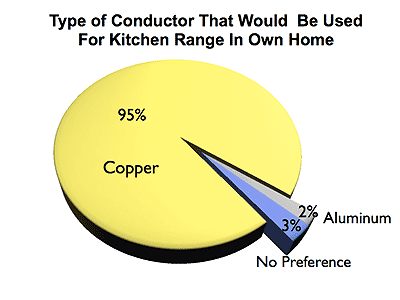
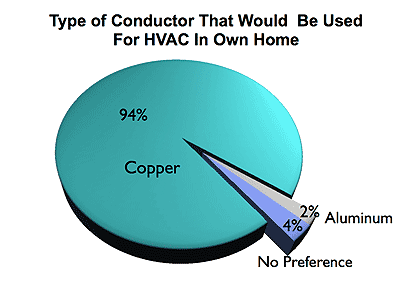
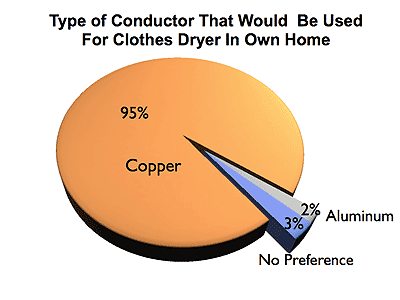
Pros Use Fewer Outlets Per Branch
In a 1999 survey, IAEI respondents reported that their jurisdictions allowed, on average, 8.4 receptacles per circuit using 14 AWG, while 10 receptacles per circuit were allowed with 12 AWG. Although the electrical inspectors and engineers pointed to the benefit of being able to use more outlets per branch, their personal choices are more conservative. Here, again, safety concerns come into play with their personal allocation of receptacle outlets per circuit running below typical contractor practice. For renovations or new installations, here are the numbers of receptacle outlets the pros would use on a branch circuits:
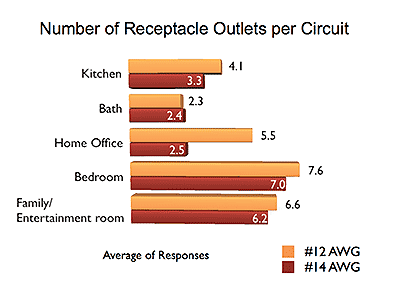 Source: CDA - IAEI Surveys
Source: CDA - IAEI SurveysFor obvious reasons, the outlet allotment when using 12 AWG wiring can be greater than that for 14 AWG circuits. It should be noted that more than 70 percent of the inspectors and engineers said they would not use 14-gauge wire in a kitchen or bath, and some 30 percent said they wouldn't use it for bedroom, family room or home office circuits.
Copper Sheds More Light
When it comes to lighting outlets, some 20 percent said they would never use 14 AWG wire for any lighting application. However, among those who would consider it for lighting, their numbers were similarly proportional to their use of receptacle outlets - again, greater capacities using 12 AWG:
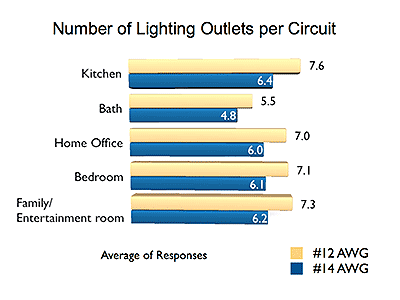 Source: CDA - IAEI Surveys
Source: CDA - IAEI SurveysMore Circuits for Future Demands
The surveys showed also that the pros would run an average of four circuits to their kitchens and four to the exterior of the home for outdoor receptacles. Again, a recognition of the constantly increasing numbers of appliances and applications demanding more and more power.
Final Thoughts
The most important takeaways from the survey is that copper is the conductor of choice for all applications. And, whether for outlets or lighting, 12 AWG copper for all branch wiring is the preference of professionals. For them, it means capability, flexibility, safety and peace of mind - both for the installer and the occupants.
Consider, too, that 12-gauge copper wire has less resistance than 14-gauge and, therefore, runs cooler (the I 2R principle). That means less energy wasted as heat, which means a more environmentally friendly installation, forever.
